Who says a machine can’t be beautiful…!? 😀
The pictures are of a MH314C 4-roll plate roll with CNC Touch Command EVO – 10′ x 9/16″.
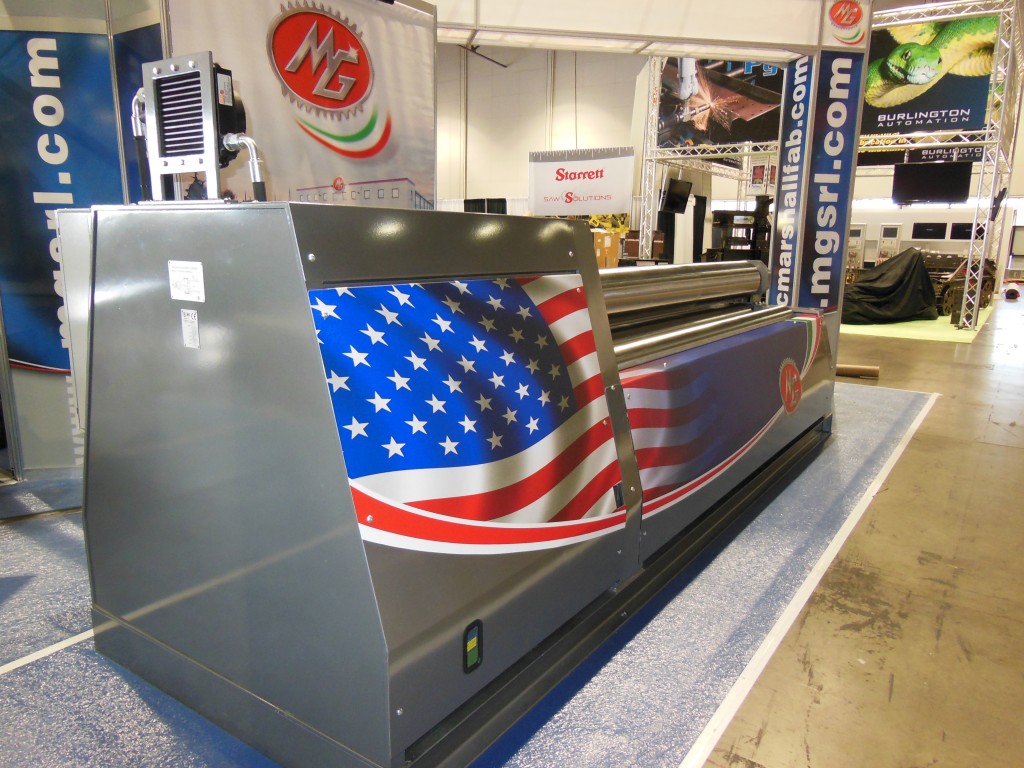
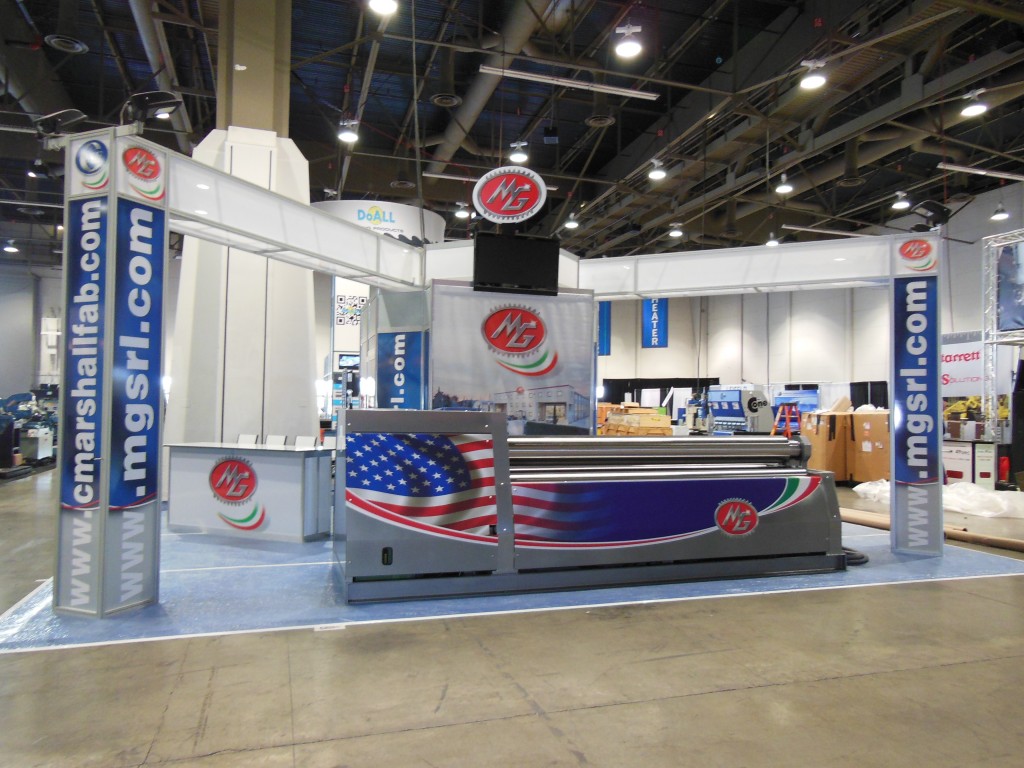
Who says a machine can’t be beautiful…!? 😀
The pictures are of a MH314C 4-roll plate roll with CNC Touch Command EVO – 10′ x 9/16″.



Welcome to our booth C7716
It is that time of the year again. After months and months of planning, selecting the booth location, budgeting, deciding on what to show, building the booth display, completing forms and ordering services, electrical outlets, carpets, padding etc. and worrying about getting the display machine to the show in time and most of all in perfect condition, we are now finally ready for this year’s show. Almost. Still a few more days to go.
We are very excited and look forward to the show. It is after all North America’s most comprehensive event for metal forming, fabricating, welding and finishing companies. Last year the show that was held in Chicago shattered all records of previous shows, with the number of buyers walking the floor, educational conference attendance and the overall square footage of exhibit space. We hope that we break another record this year.
In our booth C7716 we will showcase a MH314C 10’ x 9/16” 4-roll plate bending machine with full CNC touch command control – EVO. We would love you to come and “test drive” the machine and meet the friendly people from C Marshall Fabrication Machinery, Inc. (CMF) and MG – the factory in Italy that builds our rolls.
MG s.r.l was established in the city of Fossano, Italy in 1959. In 1981 MG began the construction of plate bending machines. Two years later the company concentrated efforts towards a quality production in the field of hydraulic plate bending machines; the original 500 sqm of covered plant surface was extended to the present 4000 sqm on a total area of over 6000 sqm.
MG is today able to answer to almost any kind of demand on plate bending machines manufacturing, and is in condition to propose a large range of models with useful plate length from 20” mm to 28’ and bending thickness capacity from .040” up to 10-1/4”.
The bending machines model MG and MH are the result of a continuous research and innovation in the product engineering and manufacturing, making use of components of the latest technology and innovative solutions. These models are designed and manufactured to obtain a bending capacity equal to 3 times the upper roll diameter with steel plates yield of 36,000.
C Marshall Fabrication Machinery, Inc. is the proud official distributor of MG’s plate rolls in USA.
Below you can see a few pictures of MH314C – the machine that will be showcased in our booth C7716.
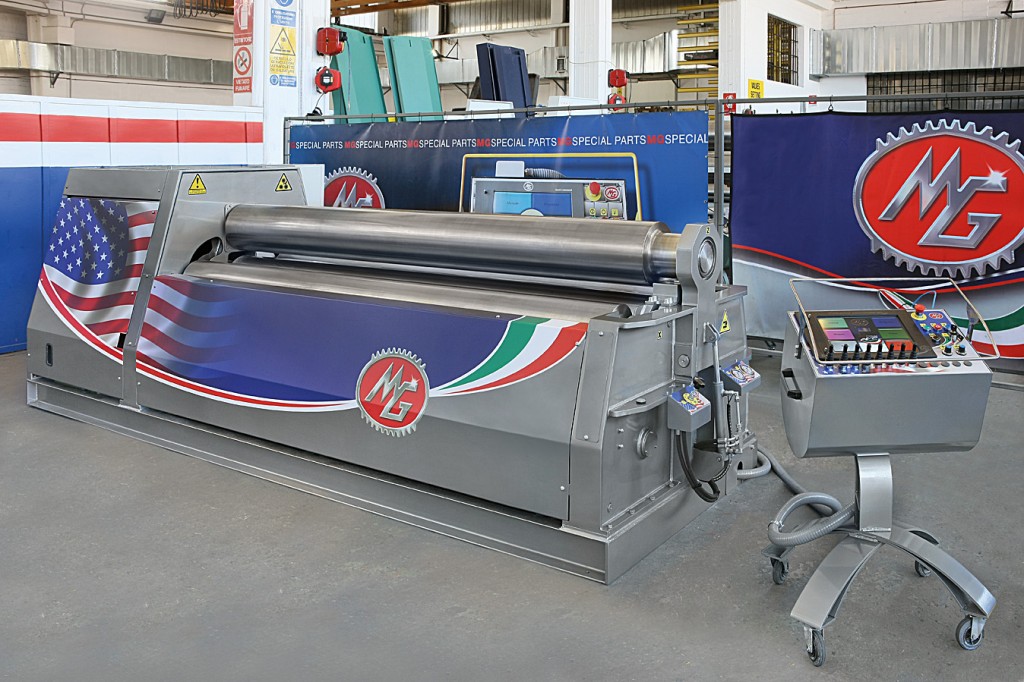
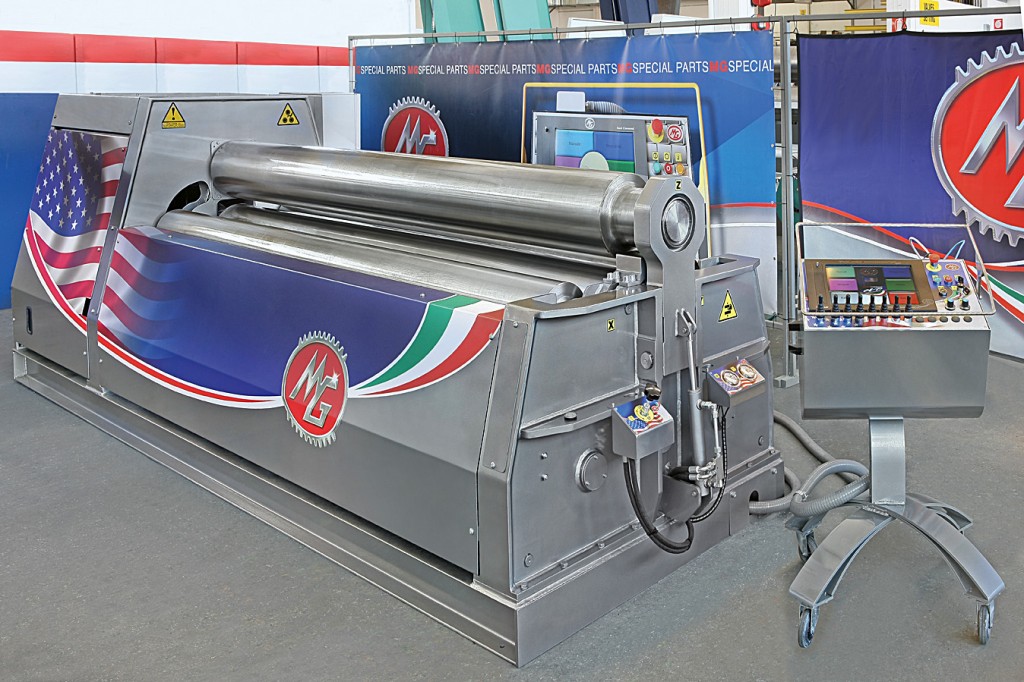
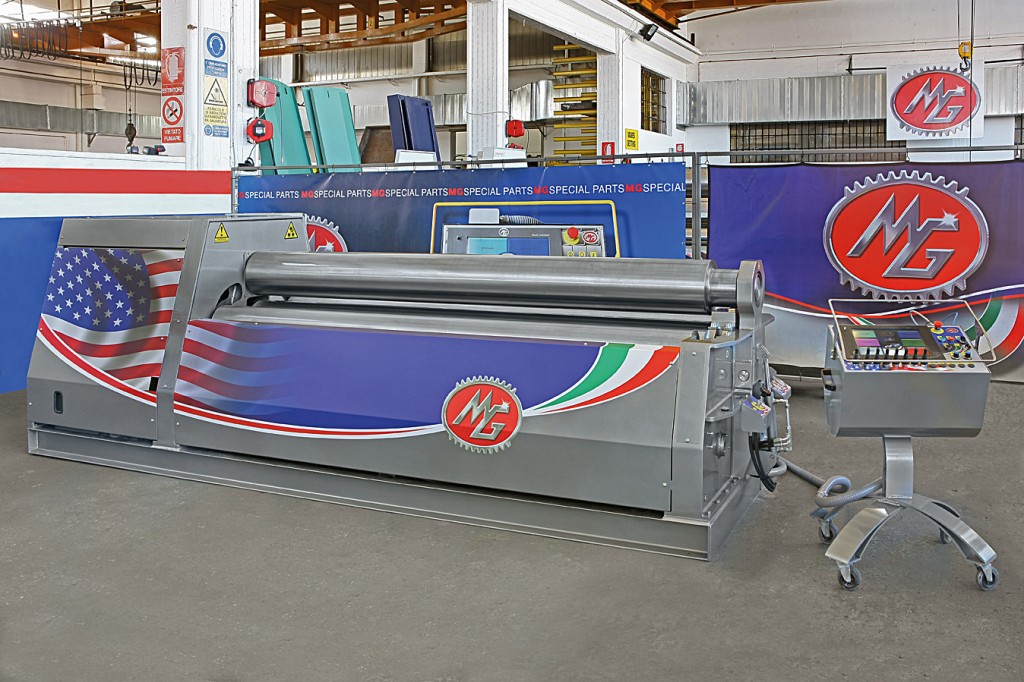
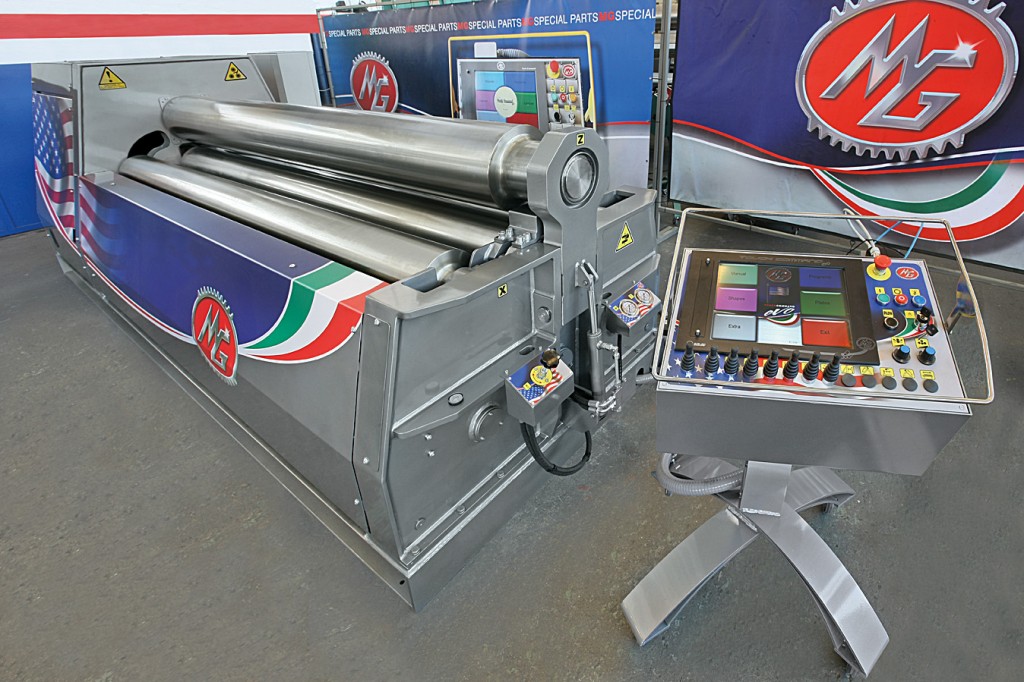
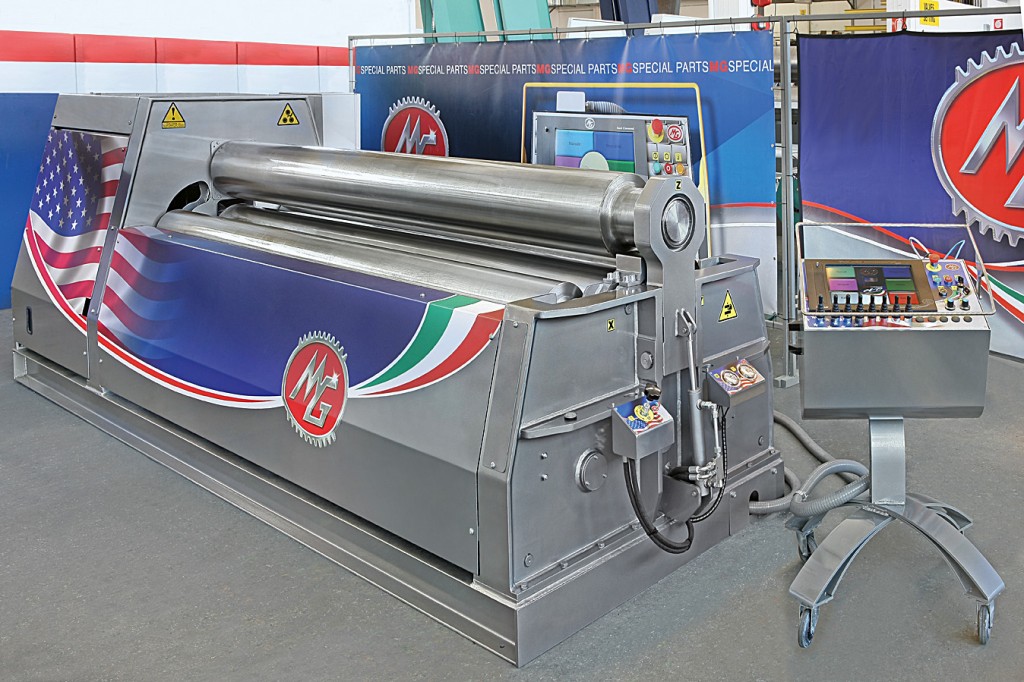
The CBS Evening News (10/19, story 5, 0:30, Pelley) reported, “We got a good jobs report today. A Labor Department report shows unemployment fell last month in 41 states, including most of swing states that may decide this election. In Nevada, unemployment has fallen from 13.6% a year ago to 11.8%. It’s still the highest in the nation. In Ohio it’s down from 8.6% to seven, and in Florida unemployment fell from 10.4% to 8.7%.”
The AP (10/19, Rugaber, Pace) reported unemployment “fell last month in nearly all of the battleground states that will determine the presidential winner,” giving President Obama “fresh fodder to argue that voters should stick with him in an election focused squarely on the economy.”
The Wall Street Journal (10/20, Mitchell) reported jobs were added in most of the 41 states where the unemployment rate declined.
The Washington Post (10/20) and Los Angeles Times (10/20, Lifsher, Flores) also covered the story.
From Daily Executive Briefing 10/22/2012
Manufacturing in the Philadelphia region expanded in October for the first time in six months, a sign the industry may be starting to stabilize.
The Federal Reserve Bank of Philadelphia’s general economic index rose to 5.7 from minus 1.9 in September, a report today showed. A reading of zero is the dividing line between expansion and contraction. The median forecast of 61 economists surveyed by Bloomberg was for an increase to 1.
he report, contrasting with data showing New York-area factories shrank for the third straight month, indicates that a pillar of the recovery is starting to regain its footing. Gains in confidence and household wealth mean consumer spendingmay help cushion manufacturing at a time when business investment and exports are hurt by slowing global growth and uncertainty about U.S. tax changes.
“Manufacturing has troughed in terms of the declines in activity,” Russell Price, senior economist at Ameriprise Financial Inc. in Detroit, said before the report. “As the recession in Europe becomes less severe, it will take the pressure off exports. There is some demand” in the U.S.
The Philadelphia Fed’s report covers eastern Pennsylvania, southern New Jersey and Delaware. Estimates in the Bloomberg survey ranged from minus 2.7 to 5.8.
Other reports today showed more Americans than forecast filed applications for unemployment benefits last week,consumer confidence rose to a six-month high and the index of leading indicators climbed more than forecast in September.
Jobless claims increased by 46,000 to 388,000 in the week ended Oct. 13, reflecting an unwinding of adjustments for seasonal swings at the start of a quarter, from a revised 342,000 the prior period that was the lowest since February 2008, according to Labor Department data.
The Bloomberg Consumer Comfort Index rose to minus 34.8 in the week ended Oct. 14, the highest level since April, from minus 38.5 the previous week. The monthly expectationsgauge improved to minus 7 in October, the best reading since May.
The Conference Board’s gauge of the outlook for the next three to six months increased 0.6 percent last month after a revised 0.4 percent drop in August that was bigger than initially reported, the New York-based group said. Economists projected the gauge would climb 0.2 percent, according to the median estimate in a Bloomberg survey.
The Philadelphia Fed’s overall index isn’t composed of the individual measures, one reason some economists consider it a gauge of sentiment among manufacturers. Manufacturing makes up about 12 percent of the U.S. economy.
The breakdown of today’s Philadelphia Fed data was less encouraging than the headline reading. The employment index decreased to minus 10.7, the lowest reading since September 2009, from minus 7.3. The new orders measure dropped to minus 0.6, the fifth contraction in the past six months, from a reading of 1 in September.
The shipments gauge climbed to minus 0.2 from minus 21.2. Its inventory index rose to 2.1 from minus 21.7.
The index of prices paid rose to 19 from 8, while a gauge of prices received increased to 5.4 from minus 0.2.
Factory managers in the region also become less optimistic about the future. The gauge of the outlook for six months from now dropped to 21.6 this month from 41.2 in September.
Figures from the New York Fed on Oct. 15 showed the so- called Empire State index rose to minus 6.2 this month from September’s minus 10.4 reading.
Economists monitor the New York and Philadelphia Fed factory reports for clues about the Institute for Supply Management national figures on manufacturing. The ISM report is due on Nov. 1.
The automobile industry remains a source of growth. Cars and light trucks sold at a 14.9 million annual pace in September, the most since March 2008, according to data from Ward’s Automotive Group. Chrysler Group LLC and General Motors Co. (GM) reported gains.
Businesses restrained by weakening overseas growth include Alcoa Inc. (AA), the largest U.S. aluminum producer. The New York- based company cut its forecast for global consumption of the metal on slowing Chinese demand.
“We do see a slight slowdown in some regions in end- markets, and the main driver for this isChina,” Chairman and Chief Executive Officer Klaus Kleinfeld said on a conference call with analysts this month.
Manufacturing also is stabilizing at the national level, a report showed this week. Industrial production, or output at factories, mines and utilities, rose 0.4 percent in September after a 1.4 percent drop in August that was the biggest since March 2009, according to Fed data issued Oct. 16.
To contact the reporter on this story: Shobhana Chandra in Washington at schandra1@bloomberg.net
To contact the editor responsible for this story: Christopher Wellisz at cwellisz@bloomberg.net
The nation’s jobless rate dropped to its lowest point in nearly four years in September. And unlike some recent declines, this one happened for the right reason: not because people gave up looking for a job, but because far more people reported having one.
It is a surprising improvement in a job market that had appeared listless in recent months. Although employers added a modest 114,000 jobs in September, the unemployment rate dropped sharply, from 8.1 to 7.8 percent, the government reported Friday.
Unemployment is at its lowest level since President Obama took office in January 2009, offering him a political boost just days after his performance was widely judged as lackluster during a debate against GOP rival Mitt Romney.
The government said hourly wages were up and employees worked more hours in September, meaning they were taking home bigger checks. Overall, the ratio of the American population with a job reached its highest level since May 2010.
The drop in the unemployment rate was bolstered by revisions reflecting that employers had added 86,000 more jobs than previously known in July and August, recasting the troubling summer lull in job creation to a season of solid employment gains.
Although the report offered a brightening picture of the nation’s labor market, the overall rate of job creation remains less than robust. In addition, unemployment remains far above normal levels, and many millions who have jobs are not working full time.
“While the September employment report was more encouraging than the ones we have seen in recent months, the job market is still a long way from rosy, good health,” said Gary Burtless, a Brookings Institution economist.
This year, employers have added only slightly more jobs per month than are needed to keep pace with normal labor-force expansion, and slightly fewer than the 153,000 average monthly gain the nation experienced in 2011. Also, the number of Americans working part-time — even though they want full-time jobs — rose sharply last month to 8.6 million.
With economic growth creeping along after showing signs of more vigorous expansion last year, some economists were skeptical of the magnitude of September’s unemployment decline. A few even predicted that the jobless rate would tick up in the coming months.
“This was a pretty good report, but the drop in the unemployment rate was just too good to be true and probably overstates the degree of improvement in the job market,” said Stuart G. Hoffman, chief economist for PNC Financial Services Group.
Even at 7.8 percent, the joblessness rate remains high by any historical standard. And it could be years before the economy returns to full employment.
But Bernard Baumohl, chief global economist for the Economic Outlook Group, said the dichotomy between the recent steep decline in the jobless rate and the slow economic growth in recent months could mean that the economy is poised to take off.
Economic “growth may turn out to be stronger than most economists currently forecast,” he said. “ . . . Employers are, thus, cautiously turning more optimistic about the economy in 2013 and becoming less apprehensive about hiring.”
Source: Washington Post (10/6, Irwin, Henderson)
Manufacturing unexpectedly expanded in September after three months of contraction, reflecting stronger orders that ease concern the U.S. economy will slow further.
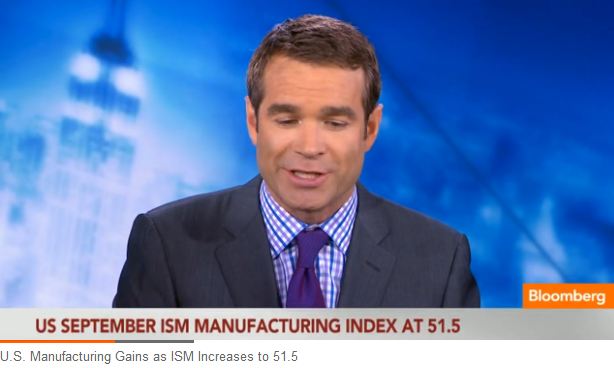
Click image above: Oct. 1 (Bloomberg) — Bloomberg’s Erik Schatzker reports that the Institute for Supply Management’s U.S. factory index rose to 51.5 in September from 49.6 a month earlier. The dividing line between expansion and contraction is 50. He speaks on Bloomberg Television’s “Market Makers.”
The Institute for Supply Management’s factory index rose to 51.5 last month from 49.6 in August, the Tempe, Arizona-based group said today. Readings above 50 show expansion, and the September measure exceeded the most optimistic forecast in a Bloomberg survey.
Stocks extended gains after the figures showed American factories are holding up in contrast to their counterparts inEurope and Asia. Sustained strength in motor vehicle sales and a rebound in demand for home construction materials are helping cushion manufacturers from weaker exports and cutbacks in business investment.
“Housing is definitely supporting,” said Michael Feroli, chief U.S. economist at JPMorgan Chase & Co. in New York. “The economy still seems to be expanding, even if modestly, and that should keep overall manufacturing growing.” Still, “it’s hard to see things materially accelerating from here.”
The median forecast in the Bloomberg survey was 49.7, andestimates from the 76 economists surveyed ranged from 48 to 51.2. A reading above 42.6 generally indicates an expansion in the overall economy, the ISM said. The gauge averaged 55.2 in 2011 and 57.3 a year earlier.
Homebuilding outlays climbed 0.9 percent in August, a report from the Commerce Department showed today. A drop in non- residential projects pushed down overall construction spendingby 0.6 percent, the most since July 2011.
Federal Reserve Chairman Ben S. Bernanke today renewed a pledge to sustain record stimulus even after the U.S. expansion gains strength, while saying policy makers don’t expect the economy to remain weak through 2015.
“We expect that a highly accommodative stance of monetary policy will remain appropriate for a considerable time after the economy strengthens,” Bernanke said in a speech in Indianapolis. Policy makers’ forecast to hold the main interest rate near zero until at least mid-2015 “doesn’t mean that we expect the economy to be weak through” that year.
The Standard & Poor’s 500 Index climbed 0.3 percent to 1,444.49 at the close in New York. Treasuries were little changed with the yield on the benchmark 10-year note at 1.62 percent compared to 1.63 late on Sept. 28.
The ISM’s new orders measure rose to a four-month high of 52.3 from 47.1. The employment index advanced to 54.7 from an almost three-year low of 51.6 the prior month. The gain from August was the biggest since October 2009. The group’s measures of production, export demand, prices paid and order backlogs also climbed in September.
A pickup in new-home construction and stronger auto sales are sources of strength for manufacturing. Housing starts increased in August, reflecting the strongest pace of single- family projects in more than two years, Commerce Department figures showed Sept. 19.
Autos in August sold at a 14.46 million annual rate, the fastest since the surge in August 2009 tied to the government’s “cash-for-clunkers” program. They were up from a 14.05 million pace in July, according to data from Ward’s Automotive Group.
The ISM figures compare with others showing weakness worldwide. In the euro-area, manufacturing contracted for a 14th month in September, suggesting the economy may have struggled to avoid a recession in the third quarter. A gauge of the industry in the 17-nation currency region based on a survey of purchasing managers was 46.1, Markit Economics said today. The index has held for 14 months below 50, indicating contraction, and fell as low as 44 in July.
U.K. factories shrank more than economists forecast and export orders declined for a sixth month. A measure based on a survey of purchasing managers fell to 48.4 from 49.6 in August, Markit Economics and the Chartered Institute of Purchasing and Supply said in London today.
In China, manufacturing contracted for an 11th straight month, increasing pressure on the government to bolster growth in the world’s second-largest economy. The purchasing managers’ index from HSBC Holdings Plc and Markit Economics was at 47.9 last month, compared with 47.6 in August. Export orders declined at the fastest pace in 42 months and factory purchasing activity fell for a fifth consecutive month, the Sept. 29 report showed.
“Manufacturing in the U.S. looks surprisingly good against a backdrop of weak performance in China and the euro area and the looming fiscal cliff,” said Dirk Chlench, head of bond research at Landesbank Baden-Wuerttemberg in Stuttgart, Germany, who had the highest ISM projection, 51.2, in the Bloomberg survey.
Still, some companies, like steel-processor Worthington Industries Inc. (WOR), are tempering their outlook.
“We don’t have a great deal of clarity on where the economy is going,” John McConnell, the Columbus, Ohio-based company’s chairman and chief executive officer, said on a Sept. 27 earnings call. “We’re also not saying that everything’s horrible out there. We’re saying we have some reason to be cautious.”
Caterpillar Inc. (CAT), the world’s biggest construction and mining equipment maker, last week cut its forecast for 2015 earnings after commodity producers reduced capital expenditures. While a global recession remains possible, Caterpillar is forecasting moderate and “anemic” growth through 2015, Chairman and Chief Executive Officer Doug Oberhelman said in a presentation to analysts on Sept. 24.
“We are in no way thinking we’re going to see a recession in 2013,” Oberhelman said. “Europe’s in recession today, probably going be a while to dig out.”
To boost growth and stimulate more hiring that may provide a spark for the economy, the Fed last month said it would keep its target interest rate close to zero until at least mid-2015 and began a third round of stimulus, buying $40 billion in mortgage bonds a month.
“If the outlook for the labor market does not improve substantially, the committee will continue its purchases of agency mortgage-backed securities, undertake additional asset purchases and employ its other policy tools as appropriate,” the Federal Open Market Committee said Sept. 13 in a statement at the end of a two-day meeting in Washington.
To contact the reporter on this story: Michelle Jamrisko in Washington atmjamrisko@bloomberg.net
To contact the editor responsible for this story: Christopher Wellisz at cwellisz@bloomberg.net
In an election focused on jobs, President Barack Obama can boast of crossing one milestone: the longest stretch of employment gains in manufacturing in almost two decades.
The BGOV Barometer shows U.S. factory positions have grown since early 2010, arresting a slide that began toward the end of the 1990s. It’s the best showing since the era of Bill Clinton, the only president in the last 30 years to leave office with more factory jobs than when he began.
“The gain in manufacturing jobs is certainly helpful, it is one way to show we’re moving forward,” said Terry Madonna, a political science professor and director of the Franklin & Marshall College poll in Lancaster, Pennsylvania. “President Obama has to create a psychology all over the country that things are getting better. This is a piece explaining that idea.”
Obama and Republican presidential challenger Mitt Romneyhave visited factories to promise voters they can boost the labor market, which would accelerate consumer spending, the biggest part of the economy. The U.S. has made up 4.1 million of the 8.8 million overall jobs lost as a result of the 18-monthrecession that ended in June 2009, with unemploymentexceeding 8 percent for 43 consecutive months, a post-World War II record.
The revival of factory employment may matter most in battleground states including Michigan,Ohio and Pennsylvania, Madonna said. Obama is leading Romney in Ohio “by a larger margin than many of us had thought possible, to a great extent because of the auto industry bailout,” he said, so “saving auto jobs is an agenda the president can push in such places.”
In a larger context, factory jobs are rebounding off a low base, and an employment level of 12 million in August is down from 17.9 million in 1990. Even so, gains in all except three months since February 2010 provide “reason to believe manufacturing employment may have turned the corner,” said Muir Macpherson, a Bloomberg Government economist in Washington who analyzed the government data on factory jobs.
“This is the first sustained increase we’ve seen in a long time,” Macpherson said. A continuation of the trend may mean factory employment by the end of a second term for Obama would be higher than when he took office in 2009, putting him in the company of Clinton, he said. The progress so far also contrasts with the job losses seen during the recovery from the 2001 recession, when George W. Bush was president, he said.
One area where the Obama administration can take credit for the pickup is for “not getting in the way of the renaissance in the natural-gas industry,” said Thomas Duesterberg, former chief executive officer of Arlington, Virginia-based Manufacturers Alliance/MAPI. “It could become a very important contributor to growth in manufacturing and manufacturing-related employment,” he said.
More jobs at factories are mainly an outcome of longer-term trends including rising productivity and innovation, a weaker dollar and free trade agreements, he said.
“There’s something of a revival in American manufacturing employment,” said Duesterberg, executive director of Aspen Institute’s Manufacturing and Society in the 21st Century program. “We’re done with the reduction phase and into the expansion phase. Given the many difficulties in the U.S. and global economy, it’s reassuring that we’ve achieved the job growth that is taking place.”
To contact the reporter on this story: Shobhana Chandra in Washington atschandra1@bloomberg.net
To contact the editor responsible for this story: Christopher Wellisz in Washington atcwellisz@bloomberg.net
Confidence among American consumers jumped more than forecast in September as a budding housing recovery and rising stock prices gave households reason to be more upbeat.
The Conference Board’s sentiment index increased to 70.3, the highest level in seven months, from 61.3 in August, figures from the New York-based private research group showed today. The reading exceeded the most optimistic projection of economists surveyed by Bloomberg. Another report showed home values rose by the most in two years.
Consumers felt better about their chances of landing a job soon and about the employment outlook over the next six months, today’s report showed, easing one of the impediments to the spending that accounts for 70 percent of the economy. The boost in confidence also comes just over a month before Americans go to the polls, giving President Barack Obama’s re-election prospects a lift.
“The consumer is hanging in there,” said Joseph LaVorgna, chief U.S. economist at Deutsche Bank Securities Inc. in New York. “It’s one of the reasons we’re not totally pessimistic about the economy. Spending is growing, but we need more things to contribute.”
Stocks fell on concern global stimulus measures will not be enough to boost growth. The Standard & Poor’s 500 Index dropped 1.1 percent to 1,441.59 at the close in New York, a fourth consecutive decline. Treasury securities climbed, sending the yield on the benchmark 10-year note down to 1.67 percent from 1.71 percent late yesterday.
Globally, sentiment hasn’t held up as well. French industrial confidence held this month near its lowest in more than two years as the economy stagnates and tax increases loom, figures from the national statistics office Insee showed today in Paris.
In Australia, households are building a financial cushion by repaying mortgages faster and saving more, while businesses are indicating renewed willingness to borrow, the nation’s central bank said.
Estimates for the Conference Board’s U.S. consumer sentiment gauge ranged from 60 to 70 in the Bloomberg survey of 73 economists.
Amelia Guckenberg, 27, an attorney in Richmond, Virginia, is among those Americans sensing the economy is getting better and, as a result, is more comfortable spending.
“I know that the jobs numbers are increasing, not dramatically, but incrementally things are getting better,” she said. “I am definitely pretty conservative when it comes to personal spending, but I am a little more confident now. I feel less worried about spending on myself, taking shopping trips, buying clothing, stuff like that.”
Apple Inc. (AAPL) sold more than 5 million iPhone 8s in the first three days it was available, surpassing a record set last year by the previous model, the Cupertino, California-based company said yesterday. The demand fell short of some analysts’ estimates as the company said supply constraints delayed shipments.
Apple is “working hard to get an iPhone 5 into the hands of every customer who wants one as quickly as possible,” Chief Executive Officer Tim Cook said in the statement.
The Conference Board’s measure of present conditions increased to a five-month high of 50.2 from 46.5 in August. The measure of expectations for the next six months advanced to 83.7, the highest since February, from 71.1.
The percent of respondents expecting more jobs to become available in the next six months climbed to the highest since February, while the share of those who expect their incomes to rise over the same period rose to the highest level of the year.
Stabilization in housing is probably playing a role in the improvement in confidence. Home pricesin July rose 1.2 percent from a year earlier, the biggest 12-month increase since August 2010, according to S&P/Case-Shiller data released today in New York. Property values in July were up 0.4 percent from the previous month. The Federal Housing Finance Agency’s purchase- onlyhome-price index, also released today, showed a 0.2 percent gain in July after 0.6 percent increases the prior two months.
“We’re finally seeing a more sustained and broad-based improvement in home prices,” saidMillan Mulraine, senior U.S. strategist for TD Securities in New York, who correctly projected the year-over-year increase. “The housing sector has made an important turn here, and that is being sustained.”
Also brightening household moods, the S&P 500 has gained 16 percent this year through yesterday.
Today’s confidence report parallels strength in other indicators. The Bloomberg Consumer Comfort Index climbed to a seven-week high in the period ended Sept. 16. The Thomson Reuters/University of Michigan preliminary sentiment index rose this month to the highest level since May.
Improving consumer moods may bolster President Obama, a Democrat, in a campaign that has been largely fought on economic issues.
A survey by the Pew Research Center conducted Sept. 12-16 showed Obama with a 51 percent to 43 percent lead over Republican Mitt Romney among likely voters, a bigger September gap than the last three candidates who went on to win in November. The survey of 2,192 likely voters has a margin of error of plus or minus 2.4 percentage points.
Results of a Gallup poll issued today showed the gain in confidence is tied to political affiliations. Democrats’ views on the economy shot up 10 points in the week ended Sept. 23, while that for Republicans dropped five points, according to Gallup. For independents, a key swing group, sentiment fell four points last week.
Unemployment, which has exceeded 8 percent for 43 straight months, the longest stretch in records dating back to 1948, remains a concern. That’s why Federal Reserve policy makers this month pledged to continue to buy assets and pump money into the economy until the jobless rate drops.
“The economy is still pretty sluggish with unemployment where it is and with consumer confidence where it is,” Tom Folliard, president and chief executive officer of CarMax Inc., a Richmond, Virginia-based used-vehicle retailer, said during a Sept. 20 earnings call. “I still think we have that kind of the economy hanging over our customer traffic.”
To contact the reporters on this story: Alex Kowalski in Washington at akowalski13@bloomberg.net
To contact the editor responsible for this story: Christopher Wellisz cwellisz@bloomber.net
Bloomberg News (9/6, Chandra, Kowalski) reports, “Companies added more workers than forecast in August, easing concern the US job market may be stalling, a private report based on payrolls showed. The 201,000 increase in employment, the biggest gain in five months, followed July’s revised 173,000 rise,” according to ADP Employer Services. “A sustained pickup in hiring would help generate the wage gains needed to spur consumer spending, the biggest part of the economy.”
CNN Money (9/7, Hargreaves) reports, “And more good news on the jobs front: Two separate reports showed that layoffs are on the decline. The Labor Department said that 365,000 people filed for first-time unemployment claims in the week ended September 1, a 12,000 drop from the week before. And another report put out by outplacement firm Challenger, Gray, & Christmas showed that planned job cuts hit a 20-month low. Despite the upbeat economic reports, most economists said it will not significantly impact their expectations for a relatively lackluster number from the government’s highly anticipated monthly jobs report, set for release” today.
Also covering the story are McClatchy (9/7, Hall), USA Today (9/7, Davidson), Forbes (9/7, Brown), Reuters (9/7), the UK’s Financial Times (9/6, Raval, Politi, Subscription Publication) and other media sources.
From SME Daily Executive Briefing 9/7/2012